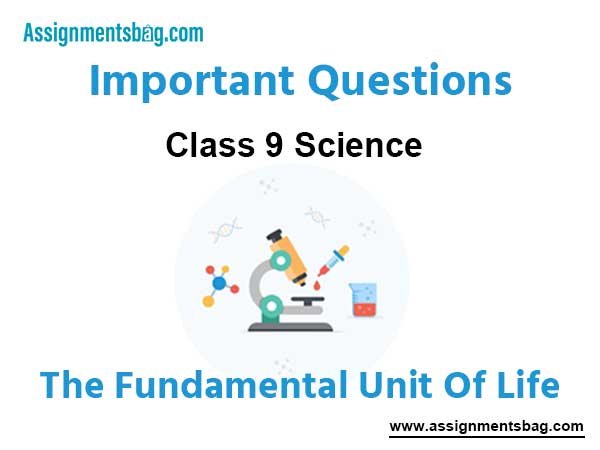Please refer to The Fundamental Unit Of Life Class 10 Science Important Questions with solutions provided below. These questions and answers have been provided for Class 10 Science based on the latest syllabus and examination guidelines issued by CBSE, NCERT, and KVS. Students should learn these problem solutions as it will help them to gain more marks in examinations. We have provided Important Questions for Class 10 Science for all chapters in your book. These Board exam questions have been designed by expert teachers of Standard 10.
Class 9 Science Important Questions The Fundamental Unit Of Life
Question. Can you name the two organelles we have studied that contain their own genetic material?
Answer. Mitochondria and plastids.
Question. If the organisation of a cell is destroyed due to some physical or chemical influence, what will happen?
Answer. The cell will not be able to perform its basic functions and will die after sometime.
Question. Who discovered cells and how?
Answer. Cell was discovered by Robert Hooke with the help of his self designed microscope. He examined a thin slice of cork and saw that the cork resembled the structure of a honey comb consisting of many compartments.
Question. What would happen if the plasma membrane ruptures or breaks down?
Answer. In case of plasma membrane ruptures or breaks down: All the useful substances will move out of the cell There will be no difference between cell content and its external environment. The cell will close its normal shape.
Question Which organelle is known as the power house of the cell? Why?
Answer. The organelle mitochondria known as the power house of the cell. Process of cellular respiration takes place in mitochondria to generate energy required for various chemical activities in the form of ATP. This is the reason that mitochondria is known as power house of the cell.
Question What is osmosis?
Answer. The movement of solvent from a region of its high concentration to a region of its low concentration through a semipermeable membrane is called osmosis. During osmosis, the water molecules (solvent) are free to cross the plasma membrane in both the directions.
Question. Carry out the following osmosis experiments Take four peeled potato halves and scoop each one out to make potato cups. One
of these potato cups should be made from a boiled potato. Put each potato cup in a trough containing water. Now
(a) Keep cup A empty
(b) Put one tea spoon sugar in cup B.
(c) Put one tea spoon salt in cup C.
(d) Put one tea spoon sugar in the boiled potato cup D.
Keep these for two hours. Then observe the four potato cups and answer the following:
(i) Explain why water gathers in the hollowed portion of B and C?
(ii) Why is potato A necessary for experiment?
(iii) Explain why water does not gather in the hollowed out portion of A and D?
Answer. (i) Osmosis is the process responsible for the gathering of water in the hollowed portion of B and C. Since, the concentration of solute (sugar in cup Band salt in cup C) is higher inside the cup as compared to the water, which is outside the cup. Hence, water from its higher concentration (outside the cup) will move towards the lower concentration (inside the cup). This process of osmosis (moving in of solvent) is called endosmosis.
(ii) Potato A acts as a control for the experiment. This is required for comparing the results of the experiment.
(iii) Water does not gather in the hollowed out portions of A and D because of the following reasons:
• The hollowed portion of potato A is empty. So, because of no concentration difference, no osmosis can occur.
• The hollowed portion of potato D contains sugar in it but it is boiled. So, osmosis cannot occur as its semipermeable membrane is destroyed by boiling.



